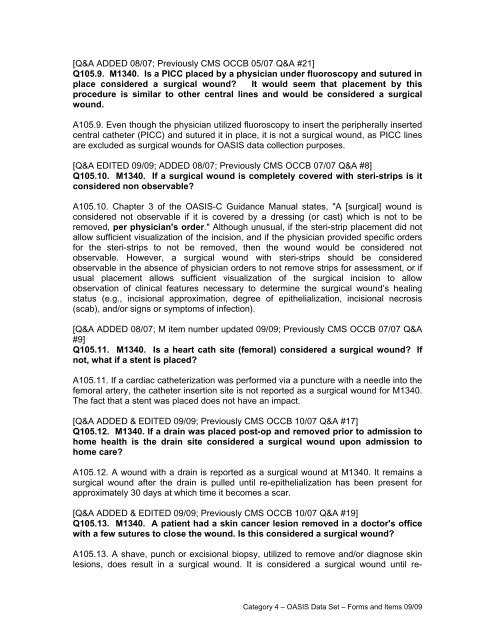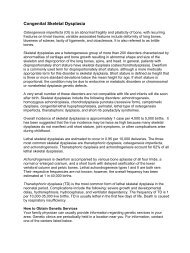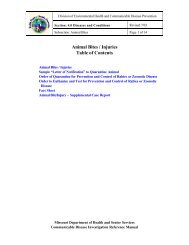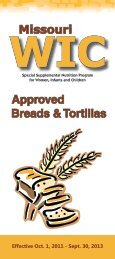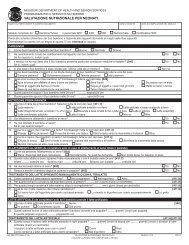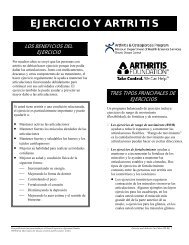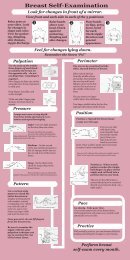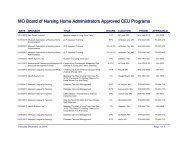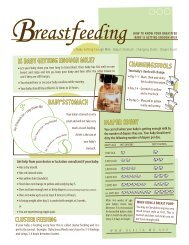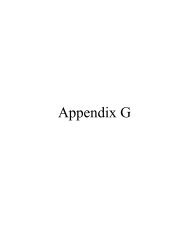category 4 a - oasis data set forms - Missouri Department of Health ...
category 4 a - oasis data set forms - Missouri Department of Health ...
category 4 a - oasis data set forms - Missouri Department of Health ...
You also want an ePaper? Increase the reach of your titles
YUMPU automatically turns print PDFs into web optimized ePapers that Google loves.
[Q&A ADDED 08/07; Previously CMS OCCB 05/07 Q&A #21]<br />
Q105.9. M1340. Is a PICC placed by a physician under fluoroscopy and sutured in<br />
place considered a surgical wound? It would seem that placement by this<br />
procedure is similar to other central lines and would be considered a surgical<br />
wound.<br />
A105.9. Even though the physician utilized fluoroscopy to insert the peripherally inserted<br />
central catheter (PICC) and sutured it in place, it is not a surgical wound, as PICC lines<br />
are excluded as surgical wounds for OASIS <strong>data</strong> collection purposes.<br />
[Q&A EDITED 09/09; ADDED 08/07; Previously CMS OCCB 07/07 Q&A #8]<br />
Q105.10. M1340. If a surgical wound is completely covered with steri-strips is it<br />
considered non observable?<br />
A105.10. Chapter 3 <strong>of</strong> the OASIS-C Guidance Manual states, "A [surgical] wound is<br />
considered not observable if it is covered by a dressing (or cast) which is not to be<br />
removed, per physician's order." Although unusual, if the steri-strip placement did not<br />
allow sufficient visualization <strong>of</strong> the incision, and if the physician provided specific orders<br />
for the steri-strips to not be removed, then the wound would be considered not<br />
observable. However, a surgical wound with steri-strips should be considered<br />
observable in the absence <strong>of</strong> physician orders to not remove strips for assessment, or if<br />
usual placement allows sufficient visualization <strong>of</strong> the surgical incision to allow<br />
observation <strong>of</strong> clinical features necessary to determine the surgical wound’s healing<br />
status (e.g., incisional approximation, degree <strong>of</strong> epithelialization, incisional necrosis<br />
(scab), and/or signs or symptoms <strong>of</strong> infection).<br />
[Q&A ADDED 08/07; M item number updated 09/09; Previously CMS OCCB 07/07 Q&A<br />
#9]<br />
Q105.11. M1340. Is a heart cath site (femoral) considered a surgical wound? If<br />
not, what if a stent is placed?<br />
A105.11. If a cardiac catheterization was performed via a puncture with a needle into the<br />
femoral artery, the catheter insertion site is not reported as a surgical wound for M1340.<br />
The fact that a stent was placed does not have an impact.<br />
[Q&A ADDED & EDITED 09/09; Previously CMS OCCB 10/07 Q&A #17]<br />
Q105.12. M1340. If a drain was placed post-op and removed prior to admission to<br />
home health is the drain site considered a surgical wound upon admission to<br />
home care?<br />
A105.12. A wound with a drain is reported as a surgical wound at M1340. It remains a<br />
surgical wound after the drain is pulled until re-epithelialization has been present for<br />
approximately 30 days at which time it becomes a scar.<br />
[Q&A ADDED & EDITED 09/09; Previously CMS OCCB 10/07 Q&A #19]<br />
Q105.13. M1340. A patient had a skin cancer lesion removed in a doctor's <strong>of</strong>fice<br />
with a few sutures to close the wound. Is this considered a surgical wound?<br />
A105.13. A shave, punch or excisional biopsy, utilized to remove and/or diagnose skin<br />
lesions, does result in a surgical wound. It is considered a surgical wound until re-<br />
Category 4 – OASIS Data Set – Forms and Items 09/09


